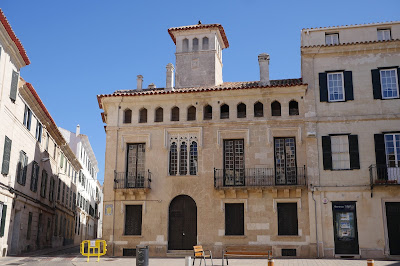Mahon harbour
We have just arrived in Mahon, the capital of Menorca. It is pronounced Ma-hon in English and called Maò by the locals. At Gatwick, the announcer summoned passengers to a flight to May-on (maybe the influence of the Conservative Party conference which is currently underway?).
We were on a very early flight and as our hotel room wouldn't be ready for some hours we decided to jump immediately into the walk around Mahon described in the vital Walking Menorca by David and Ros Brawn. We were delighted to find that the route passed close by our hotel and so we started the walk there. Our first point of reference was the 1805 house called Ca'n Oliver, which is now home to the Hernandez Sanz - Hernandez Mora Collection. The side door was impressive.
We headed east to the Park d'es Fregenal where I was delighted to spot a Monarch butterfly, which obligingly posed for some photos. Below is the best one. I discovered later that there are generally thought to be 26 species of butterfly in Menorca, not including the Monarch. So it seems that I was extremely lucky to spot one.
We exited the park and headed uphill past the Theatre and the former Hospital with its adjoining church …
… to reach Plaça de s'Esplanada where there is a monument to those who died in the Spanish Civil War (Menorca was republican).
We headed across the square to reach Carrer s'Arraval, a street with a view to the right of the Porta san Roc, the stone gateway which offers the only remaining evidence of the city walls. We had a better vantage point later in the walk, so I will defer the photo until then. Our route now headed west to the Museum of Menorca, housed in a complex of buildings, the one on the right is the Church of St Francis, a rather handsome 18th century building.
The Museum looks really interesting and we will return for a proper look later in our holiday. We headed past it to the mirador (view point) for our first view of Mahon's 4.5 km long harbour (picture
e at the head of this post).
We then walked along Isabel II street, once the most fashionable in the city. There were some pleasing art nouveau details (tiles, doors) and a real gem further along. We reached the imposing Military Governor's House, but just to its left was this much more interesting art nouveau delight (at least to my eyes).
At the of the road we turned right to reach the Town Hall (Ayuntament). It dates from 1613, but was rebuilt in 1788. The clock was the gift of the first English Governor, Sir Richard Kane.
Also in this small square was the church of Santa Maria, of which more in a moment. A detour uphill brought us to a small square with a fine view of the Arc de sant Roc from the inside. Also known as St Roch or Rocco, the saint is the patron saint of dogs and was born in Montpellier in the 14th century.
We now headed downhill to the quay and then back up via the Parc Rochina. At the top was another art nouveau building which I had identified in my pre-holiday planning, but hadn't been able to pinpoint the location of - the
C'an Mir. The closed blinds were rather a shame.
After a leisurely lunch we continued on our way passing the Chiesa del Carme (Carmelite church) (1750 - 1808) ...
… with its rather lovely 18th century cloister, spoiled by a stage and shops around the outside.
Just beyond the church in the Plaça del Princep was this splendid building whose name I haven't yet discovered.
We returned to the harbour and followed a high level path with great views – this one of the naval base on the other side.
Later the path descended to the harbour side.We followed the harbour side for a while, noting some promising restaurants to be tried later and at this point headed away from it, climbing a steep flight of stairs, to return to our hotel.
Conditions: hot and sunny (yes!).
Distance: about 4 miles.
Rating: four stars. Delightful. No single thing was really outstanding though.

















No comments:
Post a Comment